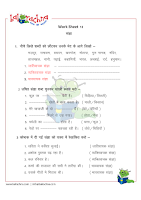In Hindi language Vachan (Number) is a grammatical term denoting number category of noun, pronoun –
Singular (एकवचन) is used when the noun refers to one object/person/place or thing.
Plural (बहुवचन) is used when a noun refers to more than one object/person/place or thing.
There are certain rules regarding the use of Vachan (Number). I have shared a worksheet with the details and other pictorial worksheets are categorized as per the different rules of changing a singular form to plural.
In this first post on Vachan(number) for classes 1,2,3 I’ve only taken up the masculine gender(पुल्लिंग) words ending with the matra ‘आ’. It follows a simple rule, the matra ‘आ’is replaced by matra ए.
eg. लड़का - लड़के , चूहा – चूहे, बस्ता – बस्ते
Important to note that changing a noun word from singular form to plural in a sentence, the verb also changes to plural.
Eg. लड़का खेल रहा है। - लड़के खेल रहे हैं।
Note – Many a time’s parents have argued over the use of है/हैं.
है – is हैं – are
लड़का खेल रहा है। - The boy is playing
लड़के खेल रहे हैं। - The boys are playing.













































